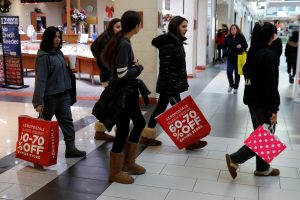
By Nandita Bose and Chriss Swaney
NEW YORK/PITTSBURGH (Reuters) – U.S. shoppers formed long lines at store checkout counters on Black Friday to snap up deep discounts on clothing and electronics, offering evidence that a healthy economy and rising wages are translating into stronger consumer spending at the start of retailers’ make-or-break holiday season.
“I am spending more, the mood generally is more upbeat,” said Sharon Neidert, 57, visiting New York City from Ohio. “My daughter moved out this year so I have more disposable income,” said Neidert, a manager at a software company.

People shop during the Black Friday sales shopping event at Roosevelt Field Mall in Garden City, New York, U.S., November 23, 2018. REUTERS/Shannon Stapleton
While online sales were up substantially and traffic looked healthy at stores offering discounts, detailed numbers on brick-and-mortar holiday sales will not be available for several days.
“Overall, Black Friday doesn’t have the sense of urgency as in the past and feels more like a busy regular weekend day in many of the stores,” said Dana Telsey at Telsey Advisory Group.
“Many of the promotions were available for the past couple of weeks,” Telsey said. “We haven’t noticed desperation from any retailer.”
Shares of U.S. department stores Macy’s Inc, Kohl’s Corp, J.C. Penney Co Inc and Target Corp were all down between 1 and 3 percent on Friday and weighed on the broader S&P 500 retailing index, down 0.15 percent.
Investors are concerned that retail peaked in the second quarter and business will slow down as comparisons get tougher, said Brian Yarbrough, retail analyst with Edward Jones.
Victoria’s Secret owner L Brands, Walmart Inc and American Eagle Outfitters were some of the top gainers, rising between 0.5 to 3 percent.
STRONG ONLINE SALES
Shoppers spent $643 million online by 10 a.m. ET on Black Friday, with smartphone sales lifting overall online spending by 28 percent from a year ago, according to Adobe Analytics, which tracks transactions at 80 of the top 100 U.S. online retailers.
Online spending is on track to hit $6.4 billion on Friday, which is likely to either match or surpass last year’s Cyber Monday revenue of $6.6 billion, Adobe said. Online sales on Thanksgiving Day were up 28 percent at $3.7 billion.
The National Retail Federation forecast U.S. holiday retail sales in November and December will increase between 4.3 and 4.8 percent over 2017 for a total of $717.45 billion to $720.89 billion. That compares with an average annual increase of 3.9 percent over the past five years.
About 38 percent of American consumers plan to shop on Black Friday, and six in 10 expect to make at least half of their holiday purchases on that day, a Reuters/Ipsos poll showed last week.
DEAL FRENZY
Shoppers picked up big-ticket items such as TVs, Apple Inc, iPads and Watches at Target, while phones, toys, gaming consoles and cookware were top sellers at Walmart Inc.
Some of the deals:
– An H&M store in Manhattan offered 30 percent off everything in-store and online.
– Macy’s in Herald Square, Manhattan, sold a Coach designer wallet, originally $225, for $53.
– Midtown Comics was taking 25 percent off everything at its Manhattan locations until noon.
– An Eddie Bauer in Chicago offered 50 percent off all items.
– At a Chicago-area Pandora, which makes popular charm bracelets that can cost up to $1,000, jewelry was 35 percent off before 10 a.m. and 25 percent off for the remainder of the day.
– J Crew clothing was 50 percent off. Its site experienced some technical difficulties before coming back up.
– Walmart was selling a Google Home mini for $99.
– Buy one, get one free pajamas at Victoria’s Secret.
Charlotte Jackson, from London, come to New York with her mother for Black Friday shopping.
“Black Friday isn’t as big of a deal back home,” Jackson, a 27-year-old tax adviser, said while shopping for lingerie and pajamas at Victoria’s Secret.
MORE TOYS AT TARGET, JC PENNEY
Many retailers, reacting to the bankruptcy of the Toys ‘R’ Us chain, are catering to parents.
Target said in October it planned to dedicate nearly a quarter of a million square feet of new space to its toy business across 500 of its stores. The discount chain’s customers will also be able to shop for more than 2,500 new and exclusive toys, Mark Tritton, Target’s chief merchandising officer said.
“Toys ‘R’ Us had better quality for toys,” said Ashley Drew, 29, shopping for her 5-year-old daughter at a Los Angeles-area Walmart, next door to the empty shell of a Toys ‘R’ Us store.
Department store JC Penney Co Inc, known for its mid-priced apparel, has also made a push into toys.
Carolyn Pertette from Wilkinsburg, Pennsylvania, shopped in the early morning at the Waterfront Mall in Pittsburgh. She said she was upset about the closing of Toys ‘R’ Us.
“I’m concerned about where I’m going to get toys for the kids,” she said.
Shortly before 6 a.m. on Friday, shoppers were banging on the door at a Bath & Body Works in the Waterfront Mall in Pittsburgh, lining up for discounted candles, soaps, and lotion, while long lines formed at checkout counters in a Dick’s Sporting Goods store in the mall.
There was little evidence of the delirious shopper frenzy of Black Fridays from past years, in other parts of the country, especially the Northeast, where crowds were thin due to cold weather.
An Athleta clothing store in Tyson’s Corner, Virginia, provided hot chocolate with marshmallows to women in line for the dressing room.
(Additional reporting by Shannon Stapleton in Long Island, Lewis Krauskopf, Jennifer Ablan and Anna Irrera in New York, Lisa Baertlein in Los Angeles, Siddharth Cavale in Bangalore; Writing by Nick Zieminski; editing by Patrick Graham, Saumyadeb Chakrabarty and Bill Rigby)










